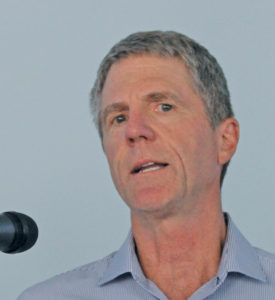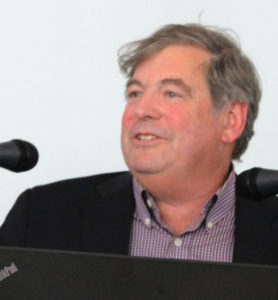By Page H. Gifford, Correspondent
The Lake Monticello Wildlife Committee presented a program Sunday (Oct. 28) featuring migratory birds with experts Paul Schmidt and Bob Ford. Schmidt, a Lake newcomer, had a 40-year career in conservation, spending 33 years as a biologist, manager, and ultimately a senior executive with the U.S. Fish and Wildlife Service and seven years as the chief conservation officer for Ducks Unlimited.
Schmidt began the presentation, speaking to a packed room full of bird lovers.
 “Birds are important; they are how we connect with the natural world,” Schmidt said. He added there are 10,000 different species of migratory birds worldwide. The U.S has 1,000 and in this area there are 200, all nesting or passing through. “They are ubiquitous, they are everywhere. They are as diverse as your imagination.”
“Birds are important; they are how we connect with the natural world,” Schmidt said. He added there are 10,000 different species of migratory birds worldwide. The U.S has 1,000 and in this area there are 200, all nesting or passing through. “They are ubiquitous, they are everywhere. They are as diverse as your imagination.”
He described many of these amazing birds, including the thick-billed murre, which is capable of diving 690 feet underwater at a rate of 6.5 feet per second, and which can make 20 consecutive dives, resting less than a minute on the surface.
Some birds, like the swifts, are able to stay aloft for almost a year, and can travel from Alaska to New Zealand in nine days. It is these birds that inspired Schmidt at a young age with their abilities and skills that at times appear like magic. Schmidt’s admiration for them is clear.
In our area we have the majestic eagle, unmistakable in its strength, flapping its eight-foot wingspan effortlessly across the sky. We also have osprey, vultures, and red-bellied woodpeckers knocking on trees. Canadian geese waddle along the water’s edge, and waterfowl, including wood ducks, blue teal males in full plumage, American black ducks and common goldeneye diving ducks, plow gently through the water.
 “Ospreys and eagles are fantastic fliers. Get children outside who are interested in nature and experience it,” Schmidt said. He discussed other nesters and cavity dwellers (birds that live in tree hollows), like the tree swallows which are in decline, according to Partners in Flight, an organization engaged in an effort to preserve land birds. He also mentioned other familiar birds, including nuthatches, the bluebird, house wrens, and the prothonotary warbler, named for judges who used to wear yellow robes.
“Ospreys and eagles are fantastic fliers. Get children outside who are interested in nature and experience it,” Schmidt said. He discussed other nesters and cavity dwellers (birds that live in tree hollows), like the tree swallows which are in decline, according to Partners in Flight, an organization engaged in an effort to preserve land birds. He also mentioned other familiar birds, including nuthatches, the bluebird, house wrens, and the prothonotary warbler, named for judges who used to wear yellow robes.
Bob Ford took over and discussed the history of bird conservation. Ford, who has a B.S. and M.S. from the University of Tennessee at Knoxville, focused his career on field ornithology and field conservation. Early on he worked for the Tennessee Conservation League and Nature Conservancy. He also worked for the U.S. Fish and Wildlife Service, issuing the first State of the Birds report for the U.S. in 2009.
He spoke about ornithologist Frank Chapman, who identified 174 birds and 40 species, hunted for recreation and adorned fashionable ladies’ hats back in the late 19th century. This resulted in a movement of birders who began appreciating birds and learning more about them through bird watching.
This also led to the 100-year-old Migratory Bird Treaty Act, which is the oldest environmental law the U.S. has. Like Schmidt, birds captured Ford’s interest at a young age with “the romance of their migration.”
“They migrate looking for food and a longer, warmer season elsewhere and fly eight to 10 hours, mostly at night on their way to Central and South America,” said Ford. “They fly 2,000 feet in the air but one has been reported flying at 37,000 feet.” Most fly at a speed of 15 to 30 miles per hour (mph) but most waterfowl, like the green-winged teal, can fly between 30-60 mph with an average of 50 mph.
He then explained site fidelity, which is when migrants return year after year to the same nesting area.
“In one study, transmitters were put on birds in an area of Tennessee that was eventually wiped out by a tornado. The birds had already migrated to Florida but when they returned, they went back to the same spot,” Ford said. He added that back in the late 19th century, the theory was that birds went underwater to hibernate, but by the 1940s and ’50s scientists had a better understanding of migration.
He stressed the importance of maintaining ecological balance and “keeping abundant birds abundant.”
“A high quality habitat is important with native plants and nesting cavities, community open space, and keeping cats indoors,” he said. “Birds are the bellwethers of our social, cultural and ecological environments.”
Schmidt wrapped up the presentation by discussing the Migratory Bird Treaty Act (MBTA). He explained the purpose of the law and why it is still important.
“Unless someone has a valid permit, it is illegal for anyone, at any time, by any means or manner to hunt, take, capture, or kill migratory birds,” he said. He further explained that the current administration has chosen to reinterpret the language of the law. “After 100 years of successful implementation, this administration wants to contrive a legal standard, creating a loophole in the MBTA, to allow companies to engage in activities that regularly kill birds as long as they were not intending that their operations would render an animal subject to human control.”
Disasters like the Exxon Valdez and the BP Deepwater Horizon oil spills, pesticides, poisons and wind turbines can kill birds. “Tens of millions of birds die each year and the MBTA motivated these industries to take measures to reduce and minimize the harm,” Schmidt said. “The new interpretation would allow companies that do not recognize the value of these birds to bear no responsibility for their deaths as a result of negligence.”
He urged anyone who loves birds and nature to write their congressperson, urging them not to change the law. He wrote his concerns, he said, and has not received a response. He added that the treaty is with Canada, Mexico, Japan and Russia.
Other questions were brought up by audience members, including how global warming may effect migration. Ford answered this question by highlighting the shifts in migration.
“If possible, they will have to move and adapt to new habitats as their current habitats change,” he said. He added that the climate may affect some migrating birds and some use instinct to make changes. “This climate change is happening and there is evidence of it. Some will adapt and thrive; others will not.”
They encouraged everyone to do anything they can to help, such as writing to Congress about the MBTA, putting up a bluebird house, keeping trees with nesting cavities, avoiding the use of pesticides and keeping cats indoors.




